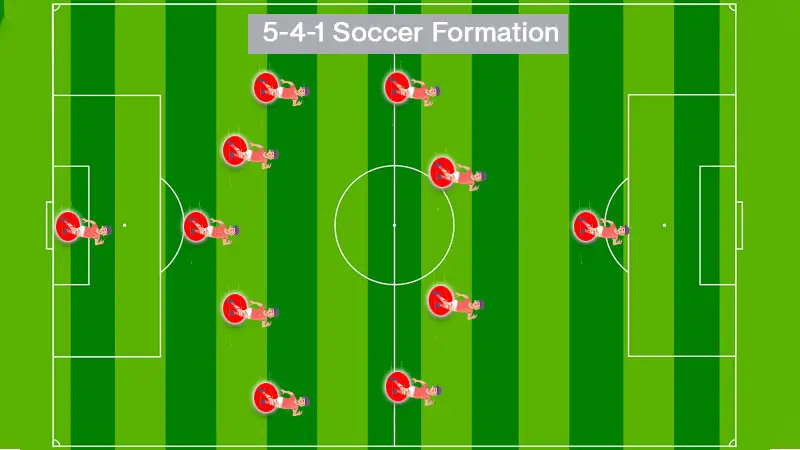The 5-4-1 soccer formation often flies under the radar, but it’s a game-changer for teams focused on solid defense and quick counter-attacks.
With five defenders, four midfielders, and a lone striker, this setup creates a fortress at the back while offering surprising offensive opportunities.
Coaches favor the 5-4-1 formation for its balance and flexibility. It allows teams to absorb pressure and launch rapid transitions from defense to attack.
Whether you’re a seasoned coach or a curious fan, understanding the intricacies of the 5-4-1 can shed light on its growing popularity in modern soccer.
When executed well, the 5-4-1 can stifle even the most potent offenses, while the lone striker, supported by versatile midfielders, can exploit gaps left by the opposition. Implementing this formation effectively requires players to be disciplined, physically fit, and tactically aware.
Overview of the 5-4-1 Soccer Formation
The 5-4-1 formation strengthens both defensive solidity and attacking potential, making it a versatile option for modern soccer. It balances structure and flexibility, aiding teams in managing different phases of the game.
Basic Structure and Player Roles
The 5-4-1 formation comprises five defenders, four midfielders, and one striker.
- Defenders: Three center-backs prioritize negating central attacks. Two wing-backs contribute both defensively and offensively by supporting forward play and recovering to defend.
- Midfielders: A central midfield duo focuses on ball control and distribution, while the wide midfielders assist in both attacking and defensive duties. This structure ensures midfield dominance and coverage across the pitch.
- Striker: The lone forward stretches the opposition’s defense, exploits spaces behind the lines, and capitalizes on counter-attacks.
Historical Context and Evolution
Initially seen in defensive-minded teams, the 5-4-1 formation has roots in strategies focused on thwarting strong offensive opponents. Teams in both club and international competitions have adopted this system, appreciating its strategic depth.
Over the decades, formations evolved, but this setup sees consistent usage due to its ability to adapt to in-game scenarios.
Recent years have showcased the formation’s flexibility, with top teams employing it to balance defense and attack effectively. Its resurgence aligns with the modern tactical focus on organized defenses combined with rapid transitions.
Advantages of the 5-4-1 Formation
The 5-4-1 formation provides several tactical advantages, making it a popular choice among many teams. It enhances defensive stability, improves counter-attacking efficiency, and strengthens set-piece play.
Enhanced Defensive Stability
The five-defender setup in the 5-4-1 formation creates a robust backline. This structure limits scoring opportunities for opponents.
With three central defenders, the team can block central attacks effectively. Wing-backs bolster defense by closing gaps on the flanks, ensuring lateral coverage.
Efficiency in Counter-Attacking
The 5-4-1 formation excels in counter-attacking. When the team regains possession, midfielders can quickly transition to offense. The lone striker stays forward, ready for a quick pass.
This rapid movement exploits gaps left by opponents. Midfield-wide players can advance, creating multiple options for the striker.
Strong Set-Piece Defense and Offense
Defensively, the 5-4-1 formation uses its plethora of defenders to mark opponents during set-pieces efficiently. It reduces the risk of conceding goals from corners or free-kicks.
Offensively, defenders pushing up during set-pieces become additional aerial threats. Midfielders provide accurate deliveries, increasing scoring chances.
Disadvantages of the 5-4-1 Formation
While the 5-4-1 formation offers significant defensive benefits, it also has notable drawbacks. Understanding these disadvantages helps teams assess whether it’s the right fit for their strategic goals.
Limited Offensive Options
In this formation, offensive players often feel isolated. With only one forward, support from midfield becomes crucial yet challenging. This isolation makes it difficult to create scoring opportunities consistently.
Teams that rely on heavy offensive play may struggle to capitalize on possession and maintain offensive pressure.
Difficulty Maintaining Possession
Possession becomes problematic with the 5-4-1 setup. Midfielders often spend more time defending than orchestrating plays, leading to fewer ball control opportunities. This formation tends to cede possession to the opponent, putting constant defensive pressure on the team.
Over time, maintaining a solid defensive stance becomes exhausting and inefficient without proper possession.
Potential Vulnerability on the Flanks
Wing-backs in the 5-4-1 formation have dual roles, covering defensive and offensive duties. Their forward runs leave gaps that quick opponents can exploit. If wing-backs can’t recover quickly, the defense faces significant pressure, especially from teams with strong wide players.
Ensuring defensive coverage on the flanks without compromising offensive duties becomes a complex task.
Strategic Implementation of the 5-4-1 Formation
Effective implementation of the 5-4-1 formation requires a strategic approach. Teams must focus on adapting tactics to leverage the formation’s strengths and mitigate its weaknesses.
Key Strategies for Successful Utilization
Effective implementation of the 5-4-1 formation hinges on solid defense, swift counter-attacks, and strategic set-piece execution to capitalize on opponent weaknesses.
Solid Defensive Shape
Maintaining a compact defensive structure is critical. The five defenders and four midfielders must coordinate to deny spaces and cut passing lanes, reducing the opponents’ attacking options.
Efficient Counter-Attacking
Quick transitions from defense to attack play a significant role. Speedy wingers and a lone forward can exploit spaces left by an over-committed opposition. Players must launch counter-attacks immediately after winning possession.
Wing-Back Roles
Wing-backs must balance their offensive and defensive duties. Their primary role involves providing width during attacks and retreating quickly to bolster the defense. Coaches should emphasize fitness and positional awareness for these players.
Set-Piece Strength
Taking advantage of set-pieces is essential. With a lineup including tall defenders, the team can become formidable during corners and free-kicks, both offensively and defensively.
Against different opponent styles
Adapting the 5-4-1 formation involves tailored strategies against diverse opponent styles, optimizing defensive solidity and counter-attacking efficiency for tactical advantage.
Against Possession-Oriented Teams
Increase midfield pressure to disrupt the opponents’ rhythm. Players must close down quickly to win back possession and reduce the opponent’s passing effectiveness.
Against Counter-Attacking Teams
Be more cautious with forward runs. Wing-backs and midfielders should limit their offensive forays to minimize exposure to quick counter-attacks.
Against High-Press Teams
Maintain composure under pressure. Defenders should use short, quick passes to avoid turnovers, and midfielders need to offer constant support to relieve pressure.
Against Physical Teams
Utilize physicality to match the opponent. Robust tackling and aerial duels become pivotal. Players must stay disciplined to avoid unnecessary fouls while challenging for the ball.
Notable Examples of Teams Using the 5-4-1 Formation
Several teams have effectively used the 5-4-1 formation to enhance their defensive stability and counter-attacking prowess.
Performance Analysis in Major Matches
Teams like Leicester City and Atlético Madrid have showcased the 5-4-1 formation in significant matches. Leicester City’s 1-1 draw against Manchester United on September 14, 2019, highlighted the formation’s defensive strength.
They absorbed pressure and countered efficiently. Atlético Madrid used the 5-4-1 to secure a crucial win against Liverpool in the 2019-2020 UEFA Champions League Round of 16.
The formation allowed them to defend deep and exploit counter-attacks, resulting in a 1-0 victory in the first leg and paving the way for their progress.
Frequently Asked Questions
What are the key strengths of the 5-4-1 formation?
The 5-4-1 formation excels in defensive solidity, counter-attacking efficiency, and set-piece strength. It allows for solid backline coverage and quick transitions to attack, making it versatile against various playing styles.
How do wing-backs function in the 5-4-1 formation?
In the 5-4-1, wing-backs play a crucial role by supporting both defense and offense. They provide width in attacks and drop back to form a five-man defensive line when needed, enhancing overall team stability.
Which notable teams have successfully used the 5-4-1 formation?
Leicester City and Atlético Madrid are prominent examples of teams using the 5-4-1 formation effectively. Leicester City’s draw against Manchester United and Atlético Madrid’s victory over Liverpool in the UEFA Champions League showcase its success.
How does the 5-4-1 formation handle different opponent styles?
The 5-4-1 formation adapts well to various opponent styles by focusing on defensive strength and quick counter-attacks. Against possession-heavy teams, it provides a compact defense, while its counter-attacking potential exploits teams that commit numbers forward.
Why is the 5-4-1 formation considered strong in set-pieces?
The 5-4-1 formation is strong in set-pieces due to its organized defensive setup and the presence of three center-backs. This formation allows teams to defend set-pieces effectively and use set-pieces as offensive opportunities through well-planned routines.
Conclusion
The 5-4-1 formation offers a robust defensive structure while providing opportunities for effective counter-attacks. Teams like Leicester City and Atlético Madrid have demonstrated its potential in high-stakes matches, proving its versatility and strength.
By leveraging the unique roles of wing-backs and focusing on set-piece strategies, teams can maximize their defensive solidity and offensive efficiency. Adapting this formation to counter various opponent styles can be a game-changer, making it a valuable strategy in modern soccer.
Coaches can tailor the 5-4-1 setup to exploit opponent weaknesses, whether facing possession-heavy teams or those relying on quick transitions.
This adaptability ensures it remains a tactical staple. Understanding the key player roles and responsibilities is essential for implementing the 5-4-1 formation effectively.
With disciplined coordination and clear communication, this setup can thwart even the most aggressive of attacks while providing a springboard for rapid offensive plays.








Brice Petersen